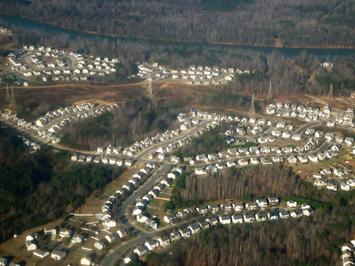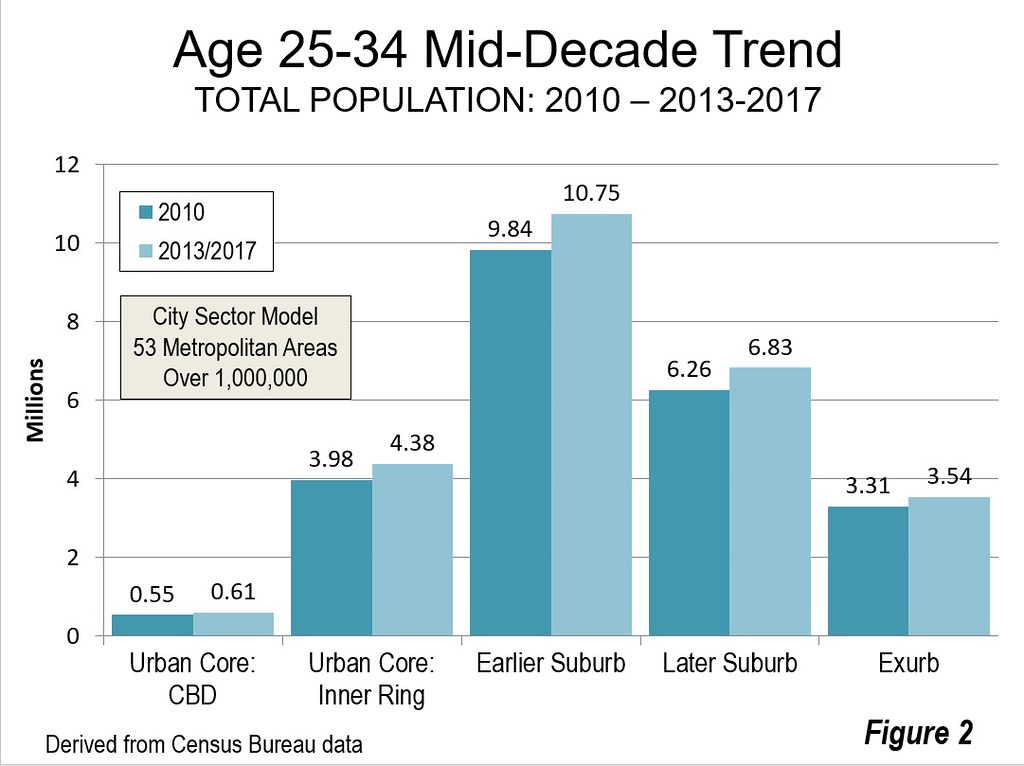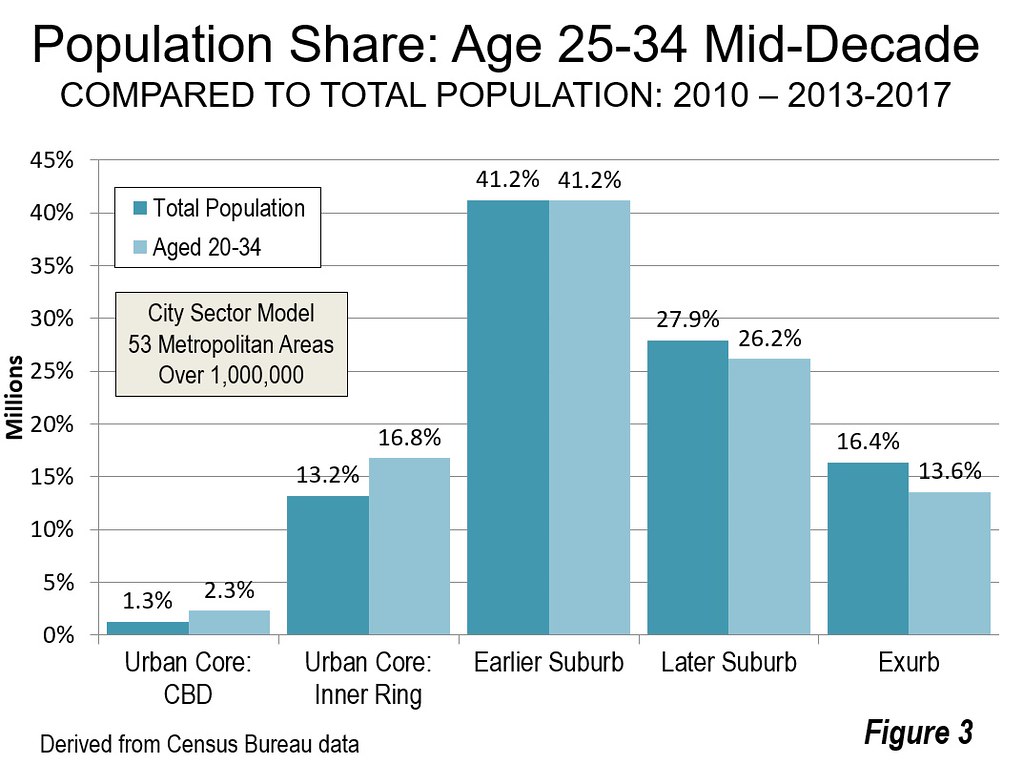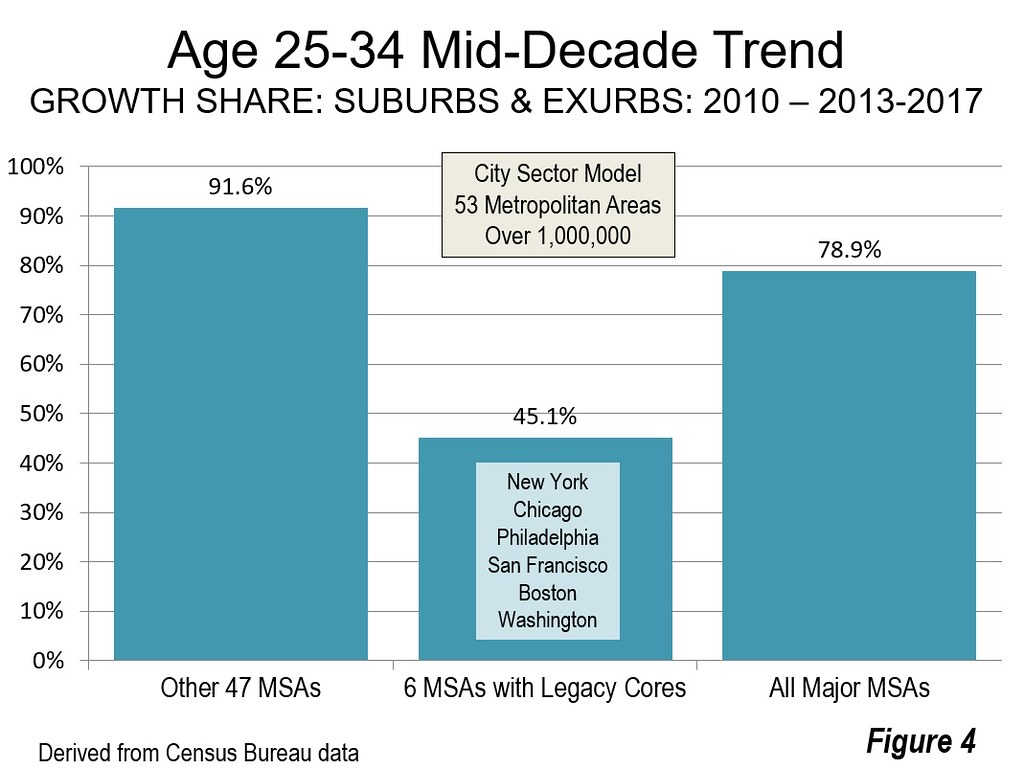
America’s suburbs and exurbs continue to dominate population growth among post-college Millennials, those aged 25 to 34 in the 53 major metropolitan areas. This is indicated by data in the just released 2013/2017 American Community Survey (ACS), which provides a mid-decade snapshot of US demography. With its middle sample year of 2015, the 2013/2017 ACS is most representative of the middle of the decade between the 2010 and 2020 censuses (Note 1).
Population Change
Between 2010 and 2013/2017, the national number of 25-34 year olds increased by more than 2 million. This analysis uses the City Sector Model (Figure 5), which classifies small areas (ZIP codes, more formally, ZIP Code Tabulation Areas, or ZCTAs) in metropolitan areas in the nation based upon their function as urban cores, suburbs, or exurbs (Note 2).
The 2013/2017 ACS data indicates that 78.9 percent of the age 25 to 34 major metropolitan area growth since the 2010 census has occurred in the suburbs and exurbs (Figures 1 and 2). Overall, the suburbs and exurbs represented nearly 1.725 million new 25-34 residents.


The suburban and exurban gains were largest in the Earlier Suburbs (generally post-World War II inner suburbs), which attracted 42.0 percent of the increase (915,000). The Later Suburbs (generally outer suburbs), accounted for 26.1 percent of the growth (570,000), while the Exurbs (generally outside the continuously built-up urban area), captured 10.8 percent of the 25-34 population growth (235,000).
The urban cores accounted for 21.1 percent of the 25-34 population growth, or 460,000 new residents. Most of this was in the Inner Ring, with 18.3 percent of the gain (400,000). The CBD (central business district) accounted for the balance of 2.3 percent (60,000).
Distribution of Population
The post-college Millennial population is somewhat more inclined than the general public to live in the urban core (Figure 3). This is especially evident in the CBD, where the share of 25-34’s is 80 percent higher than that of the total population. Both figures, it is critical to note, are very small (2.3 percent versus 1.3 percent). This propensity is also shown in the Inner Ring, where 25-34’s are about a quarter more likely to live than the overall population.

In the Earlier Suburbs, the share of 25-34’s matches that of the total, while their share is six percent less in the Later Suburbs and 17 percent less in the Exurbs.
Millennial Growth in the Urban Core?
The media and others are enamored by a perceived flocking of Millennials to the urban cores. There is certainly evidence of this in the media center of New York, where reporters can step out of their buildings to witness the phenomenon in nearby coffee shops and other gathering places. But the New York phenomenon is unique. “Global city” New York, with its many attractions, accounted for nearly one-third of the urban core gain in post-college Millennials between 2010 and 2013/2017. By comparison, New York has only 11 percent of the major metropolitan area population.
Further, nearly all of New York’s 25-34 gain was in the urban core, with only 25 percent in the suburbs and exurbs, which are more populous than the urban core. Boston was the only other metropolitan area in which most of the Millennial growth was in the urban core (54 percent).
Three more had more than 40 percent of their post-college Millennial growth in the urban cores: Philadelphia, Washington and San Francisco. These metropolitan areas, along with Chicago, have “legacy” urban cores that most resemble the pre-World War II urban form of higher population densities and substantial reliance on transit for commuting to their cores (Note 3). These six legacy urban cores accounted for more than two thirds of the 25-34 urban core population growth and combined accounted for 55 percent of the post-college Millennial population growth in their metropolitan areas.
Millennial Growth Dominated by Suburbs & Exurbs
Outside the metropolitan areas with legacy urban cores, 25-34 population growth is dominated by the suburbs and exurbs. Between 2010 and 2013/2017, nearly 92 percent of the 25-34 population growth was in the suburbs and exurbs in these 47 major metropolitan areas (Figure 4). This is double the share of growth for the same age group among the metropolitan areas with legacy cores and nearly the same as the suburban and exurban population growth share that has occurred the 53 metropolitan areas combined.


It turns out that the millennial move “back to the city” is concentrated in a few places and overall represents a small fraction of those who choose to move to suburbia.
Note 1: The ACS 2013/2017 is the most current release of the ACS 5-year product, which is released annually. It is the result of equally weighted surveys taken in each year from 2013 through 2017. Thus, characterizing results from the 2013/2017 ACS as 2017 data is inappropriate, since 80 percent of the data was collected in years before 2017. The middle year of the 2013/2017 release is 2015, making it the most representative mid-decade sample for the smaller geographies not reported in the annual sample, such as census tracts and zip codes (as used in the City Sector Model). This includes zip codes, which are used in the small area analysis produced by the City Sector Model (Note 2).
Note 2: The City Sector Model classifies small areas (ZIP codes, more formally, ZIP Code Tabulation Areas, or ZCTAs) in metropolitan areas in the nation based upon their function as urban cores, suburbs, or exurbs. The criteria used are generally employment and population densities and the extent of transit use versus car use (Figure 5). The purpose of the urban core sectors is to replicate, to the best extent possible, the urban form as it existed before World War II, when urban densities were much higher and a far larger percentage of urban travel was on mass transit. The suburban sectors replicate the automobile-oriented suburbanization that began in the 1920s and escalated strongly following World War II. The suburban areas are largely within the continuous built-up urban areas, while the exurban areas are generally in the metropolitan areas, but outside the built-up urban areas.
Note 3: The urban forms of these six “metropolitan areas with legacy urban cores” (New York, Chicago, Philadelphia, San Francisco, Boston and Washington) have suburban areas that largely resemble the suburbs in the other 47 major metropolitan areas.
Wendell Cox is principal of Demographia, an international public policy and demographics firm. He is a Senior Fellow of the Center for Opportunity Urbanism (US), Senior Fellow for Housing Affordability and Municipal Policy for the Frontier Centre for Public Policy (Canada), and a member of the Board of Advisors of the Center for Demographics and Policy at Chapman University (California). He is co-author of the "Demographia International Housing Affordability Survey" and author of "Demographia World Urban Areas" and "War on the Dream: How Anti-Sprawl Policy Threatens the Quality of Life." He was appointed to three terms on the Los Angeles County Transportation Commission, where he served with the leading city and county leadership as the only non-elected member. He served as a visiting professor at the Conservatoire National des Arts et Metiers, a national university in Paris.
Photograph: Charlotte, NC-SC suburbs (by author)













Error?
The charts refer to the 25-34 year age bracket, while the text is about the 20-34 year bracket. Is this discrepancy a typo? And if so, which one is correct?
Correct is 25-34
Thank you for catching this. It should be 25-34 in each instance in the text. Having it corrected.
Best,
Wendell Cox
Demographia
www.demographia.com